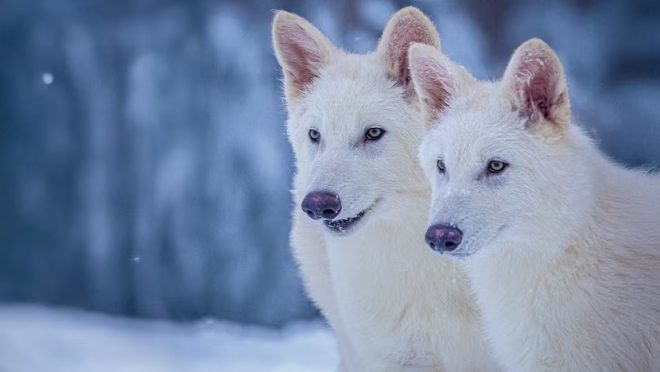The Dire Wolf project: The rise of gene editing and cloning technology?
The Dire Wolf project: The rise of gene editing and cloning technology?

Did you know that Asian elephants share 99.6% of their DNA with the extinct Woolly Mammoth? A similarity that far exceeds the relation with their African cousins. Facts like this are often unknown to the masses and these very facts have inspired scientists as well as independent companies to make an effort to bring back the once extinct animals and also take actions to conserve endangered species.
On the podcast “Joe Rogan Experience” released on 7 April, the founder of Colossal Biosciences Ben Lamm shared his company’s vision of de-extinction.
Lately, the internet has gone ablaze about the news of the revival of Dire Wolves. This species of canine had gone extinct in the late Late Pleistocene and Early Holocene epochs. Not a single dire wolf has been spotted in over 10,000 years since the species went extinct, yet it originally inhabited an American territory that stretched as far north as Canada and as far south as Venezuela. Numerous remains of dire wolves have been found in the Americas.
The common gray wolf’s genetic code was rewritten to match the dire wolf’s genome by Colossal scientists using ancient, preserved DNA and competent genetic engineering. Romulus, Remus, and their sister, 2-month-old Khaleesi, were born in three separate births last fall and this winter using domestic dogs as surrogate mothers, effectively de-extincting a line of beasts whose live gene pool long ago went extinct.
The company behind de-extinction
Colossal, a company founded in 2021 and currently employing 130 scientists, has other animals on its de-extinction wish list, including the Woolly Mammoth, the Dodo, and the Thylacine, also known as the Tasmanian Tiger. In March, the company shocked the scientific community by revealing that it had replicated mammoth DNA to create a Woolly mouse, a chimeric creature with the mammoth’s long, golden coat and accelerated fat metabolism.
On the podcast, Ben explained his explorations in Alaska in the rapidly melting permafrost and how he had found the genome of a Thylacine or Tasmanian tiger. The founder has matched a sample found in the permafrost with that of a preserved Tasmanian Tiger pup. The pup’s body was stored in formaldehyde, and the genetic relation between the two samples had miraculously matched 99.9%, which meant that they had actually linked the exact pup’s ancestry.
Process of de-extinction
Usually, a tissue sample from a donor animal must be cut, and a single cell must then be isolated for cloning. After that, the cell’s nucleus—which houses all of the animal’s DNA—is taken out and put into an ovum whose own nucleus has been cut out. After being given time to develop into an embryo, the ovum is placed in the womb of a surrogate mother. This produces a baby that is genetically identical to the original donor animal.
Dolly the sheep who was the first cloned mammal, was made in this manner in 1996. Since then, the same method has been used to clone more than 1,500 dogs, pigs, cats, deer, horses, mice, goats, and even gray wolves.
Colossal’s dire wolf research used a less intrusive method, separating cells from the blood of a donor gray wolf rather than from a tissue sample. They chose endothelial progenitor cells (EPCs), which are the cells that line blood arteries. There was no old dire wolf DNA spliced into the gray wolf’s genome; instead, the researchers altered the 14 essential genes in the cell’s nucleus to resemble those of the dire wolf. After that, a de-nucleated ovum received the modified nucleus. Forty-five of the scientists’ modified eggs were allowed to grow into embryos in the laboratory. Two surrogate hound mixes were selected primarily for their general health and, not unimportantly, their size, as they would be giving birth to huge pups, and those embryos were implanted into their wombs. One embryo took root in each mother and developed into a full-term pregnancy. (There were no miscarriages or stillbirths among the dogs.)
Romulus and Remus were born to the surrogates on 1 October 2024. A few months later, Colossal used a different surrogate female and another clutch of embryos to resume the process. Khaleesi was born to that dog on 30 January 2025.
Future projects
As well as bringing back extinct species, the company is also working on preserving existing ones. In an effort to strengthen the species overall, the company also revealed that it had successfully cloned four red wolves. The species experiences a “genetic bottleneck,” or a lack of genetic variation that can result in infertility and inherited birth abnormalities, because there are so few individuals left. Science might have a solution to replenish the gene line with fresh DNA, which is what is required.
Colossal scientists are pushing forward, and the company is already succeeding in its own unique niche—not just as a scientific endeavor, but as a powerful business. Even though it could be difficult to make money off of a mammoth, a dodo, or a dire wolf cub, Lamm sees a lot of commercial promise in the technology his scientific team is creating. It has achieved decacorn status (a private company valued greater than $10 billion) and is currently valued at $10.2 billion.


